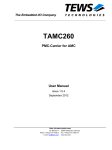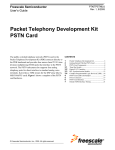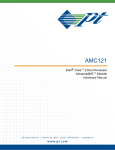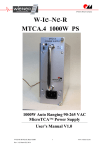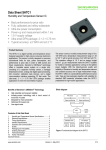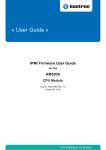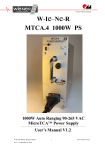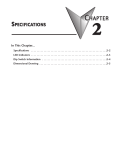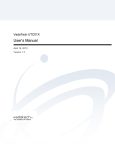Download NAMC-PMC- Technical Reference Manual NAMC-PMC AMC
Transcript
NAMC-PMC- Technical Reference Manual NAMC-PMC AMC Carrier for PMC Modules Technical Reference Manual V1.0 HW Revision 1.0 T e c h n i c a l NAMC-PMC – Technical Reference Manual The NAMC-PMC has been designed by: N.A.T. GmbH Kamillenweg 22 D-53757 Sankt Augustin Phone: ++49/2241/3989-0 Fax: ++49/2241/3989-10 E-Mail: [email protected] Internet: http://www.nateurope.com Version 1.0 © N.A.T. GmbH 2 NAMC-PMC – Technical Reference Manual Disclaimer The following documentation, compiled by N.A.T. GmbH (henceforth called N.A.T.), represents the current status of the product´s development. The documentation is updated on a regular basis. Any changes which might ensue, including those necessitated by updated specifications, are considered in the latest version of this documentation. N.A.T. is under no obligation to notify any person, organization, or institution of such changes or to make these changes public in any other way. We must caution you, that this publication could include technical inaccuracies or typographical errors. N.A.T. offers no warranty, either expressed or implied, for the contents of this documentation or for the product described therein, including but not limited to the warranties of merchantability or the fitness of the product for any specific purpose. In no event will N.A.T. be liable for any loss of data or for errors in data utilization or processing resulting from the use of this product or the documentation. In particular, N.A.T. will not be responsible for any direct or indirect damages (including lost profits, lost savings, delays or interruptions in the flow of business activities, including but not limited to, special, incidental, consequential, or other similar damages) arising out of the use of or inability to use this product or the associated documentation, even if N.A.T. or any authorized N.A.T. representative has been advised of the possibility of such damages. The use of registered names, trademarks, etc. in this publication does not imply, even in the absence of a specific statement, that such names are exempt from the relevant protective laws and regulations (patent laws, trade mark laws, etc.) and therefore free for general use. In no case does N.A.T. guarantee that the information given in this documentation is free of such third-party rights. Neither this documentation nor any part thereof may be copied, translated, or reduced to any electronic medium or machine form without the prior written consent from N.A.T. GmbH. This product (and the associated documentation) is governed by the N.A.T. General Conditions and Terms of Delivery and Payment. Note: The release of the Hardware Manual is related to a certain HW board revision given in the document title. For HW revisions earlier than the one given in the document title please contact N.A.T. for the corresponding older Hardware Manual release. Version 1.0 © N.A.T. GmbH 3 NAMC-PMC – Technical Reference Manual Table of Contents LIST OF TABLES ................................................................................................................................................ 4 LIST OF FIGURES .............................................................................................................................................. 5 1 INTRODUCTION ....................................................................................................................................... 6 2 TECHNICAL SPECIFICATIONS ............................................................................................................ 6 2.1 2.2 2.3 2.4 3 AMC BACKPLANE INTERFACE .................................................................................................................. 6 PMC INTERFACE ....................................................................................................................................... 6 POWER SUPPLY.......................................................................................................................................... 7 ENVIRONMENT .......................................................................................................................................... 7 INSTALLATION ........................................................................................................................................ 8 3.1 SAFETY NOTE ............................................................................................................................................ 8 3.2 INSTALLATION PREREQUISITES AND REQUIREMENTS ................................................................................ 8 3.2.1 Special Requirements (different to the requirements for “normal” AMCs) .................................... 9 3.2.2 Requirements ................................................................................................................................... 9 3.2.3 Power supply ................................................................................................................................... 9 3.2.4 Automatic Power Up ....................................................................................................................... 9 3.3 STATEMENT ON ENVIRONMENTAL PROTECTION ...................................................................................... 10 3.3.1 Compliance to RoHS Directive ..................................................................................................... 10 3.3.2 Compliance to WEEE Directive .................................................................................................... 10 3.3.3 Compliance to CE Directive.......................................................................................................... 11 3.3.4 Product Safety ............................................................................................................................... 11 4 HARDWARE DESCRIPTION ................................................................................................................ 12 4.1 4.2 4.3 4.4 5 HARDWARE OVERVIEW ........................................................................................................................... 13 MICRO CONTROLLER ............................................................................................................................... 13 PCIE TO PCI BRIDGE ............................................................................................................................... 13 POWER SUPPLY........................................................................................................................................ 13 CONNECTORS ......................................................................................................................................... 14 5.1 PMC CONNECTORS ................................................................................................................................. 14 5.2 AMC CONNECTOR CON1 ....................................................................................................................... 15 5.3 DIP SWITCH SW1 .................................................................................................................................... 18 5.3.1 PCIe Reference Clock Select Switch (SW1 Switch 1) .................................................................... 18 5.3.2 Reserved (SW1 Switch 2) ............................................................................................................... 18 5.4 KNOWN BUGS / RESTRICTIONS ................................................................................................................ 19 6 DOCUMENT’S HISTORY ...................................................................................................................... 20 List of Tables Table 1: Table 2: Version 1.0 PMC Connectors P11 and P12 ............................................................................. 14 AMC Connector CON1 ........................................................................................ 15 © N.A.T. GmbH 4 NAMC-PMC – Technical Reference Manual List of Figures Figure 1: Figure 2: Figure 3: Version 1.0 Block Diagram of the NAMC-PMC Carrier .......................................................... 6 Location Diagram of the NAMC-PMC Carrier (top-view) ................................. 12 Location Diagram of the NAMC-PMC Carrier (bottom-view) ........................... 12 © N.A.T. GmbH 5 NAMC-PMC – Technical Reference Manual 1 Introduction The NAMC-PMC Carrier is an AMC carrier board intended for use with a PMC or PTMC module. It allows the use of standard PMC modules in a MicroTCA or ATCA system. Block Diagram of the NAMC-PMC Carrier PTMC connectors J1 and J2 Temp. Sensor PMC Module 74mm x 149mm x 8.2mm I2C IPMI Atmel (MMC) Temp. Sensor JTAG PCI 32 bit PCIe to PCI bridge AMC Connector Figure 1: SPI PCIe x1 - AMC Port4 FCLKA M U X DIP switch NAMC-PMC Carrier Loc. 100MHz The dimensions of a single with AMC module are very similar to the dimensions of a standard PMC module. This requires some restrictions. Please refer to the Special Requirements section for a detailed description! 2 Technical Specifications 2.1 AMC Backplane Interface AMC port 4 (PCIe x1) is connected via PCIe to PCI bridge Selectable PCIe reference clock via AMC FCLKA or local oscillator JTAG 2.2 PMC Interface 32 bit PCI bus JTAG Version 1.0 © N.A.T. GmbH 6 NAMC-PMC – Technical Reference Manual 2.3 Power Supply The NAMC-PMC Carrier itself draws very little power from the supplies. The PMC +3.3V, +5V, +12V, -12V are generated from the AMC 12V payload power. 2.4 Environment Temperature (operating): 0°C to +55°C with forced cooling Temperature (storage): -40°C to +85°C Humidity: 10 % to 90 % rh noncondensing Version 1.0 © N.A.T. GmbH 7 NAMC-PMC – Technical Reference Manual 3 Installation 3.1 Safety Note To ensure proper functioning of the NAMC-PMC during its usual lifetime take the following precautions before handling the board. CAUTION Electrostatic discharge and incorrect board installation and uninstallation can damage circuits or shorten their lifetime. Before installing or uninstalling the NAMC-PMC read this installation section Before installing or uninstalling the NAMC-PMC, read the Installation Guide and the User’s Manual of the carrier board used, or of the uTCA system the board will be plugged into. Before installing or uninstalling the NAMC-PMC on a carrier board or both in a rack: - Check all installed boards and modules for steps that you have to take before turning on or off the power. - Take those steps. - Finally turn on or off the power if necessary. - Make sure the part to be installed / removed is hot swap capable, if you don’t switch off the power. Before touching integrated circuits ensure to take all require precautions for handling electrostatic devices. Ensure that the NAMC-xE1 is connected to the carrier board or to the uTCA backplane with the connector completely inserted. When operating the board in areas of strong electromagnetic radiation ensure that the module - is bolted the front panel or rack - and shielded by closed housing 3.2 Installation Prerequisites and Requirements IMPORTANT Before powering up check this section for installation prerequisites and requirements Version 1.0 © N.A.T. GmbH 8 NAMC-PMC – Technical Reference Manual 3.2.1 Special Requirements (different to the requirements for “normal” AMCs) The width of a standard PMC module is slightly larger than the width of a full width AMC module. The NAMC-PMC will still fit into a standard MicroTCA backplane, but the Backplane requires special card guides. Please contact N.A.T. GmbH for a list of backplane Vendors that support these card guides. The standard PMC face plate is not much smaller than a half height, full width AMC face plate. Therefore it is no space left to support the hot swap handle and the blue hot swap LED (even though this is required by the AMC specification). Therefore the NAMC-PMC does not support hot swap! 3.2.2 Requirements The installation requires only an ATCA carrier board, or a µTCA backplane for connecting the NAMCPMC Because the PMC Module has nearly the same size as an AMC module the NAMC-PMC carrier requires special card guides. Please contact NAT for a list of backplane Vendors that support these card guides. power supply cooling devices 3.2.3 Power supply The power supply for the NAMC-PMC must meet the following specifications: required for the carrier module: +12V / 0.6A max. the current needed by the PMC module needs to be added! 3.2.4 Automatic Power Up In the following situations the NAMC-PMC will automatically be reset and proceed with a normal power up. Voltage sensors The voltage sensor generates a reset when +12V payload power voltage level drops below 10V when +3.3V management power voltage level drops below 3.08V The PCIe to PCI Bridge will assert the PCI reset towards the PMC module until a PCIe link is established. Version 1.0 © N.A.T. GmbH 9 NAMC-PMC – Technical Reference Manual 3.3 Statement on Environmental Protection 3.3.1 Compliance to RoHS Directive Directive 2002/95/EC of the European Commission on the "Restriction of the use of certain Hazardous Substances in Electrical and Electronic Equipment" (RoHS) predicts that all electrical and electronic equipment being put on the European market after June 30th, 2006 must contain lead, mercury, hexavalent chromium, polybrominated biphenyls (PBB) and polybrominated diphenyl ethers (PBDE) and cadmium in maximum concentration values of 0.1% respective 0.01% by weight in homogenous materials only. As these hazardous substances are currently used with semiconductors, plastics (i.e. semiconductor packages, connectors) and soldering tin any hardware product is affected by the RoHS directive if it does not belong to one of the groups of products exempted from the RoHS directive. Although many of hardware products of N.A.T. are exempted from the RoHS directive it is a declared policy of N.A.T. to provide all products fully compliant to the RoHS directive as soon as possible. For this purpose since January 31st, 2005 N.A.T. is requesting RoHS compliant deliveries from its suppliers. Special attention and care has been paid to the production cycle, so that wherever and whenever possible RoHS components are used with N.A.T. hardware products already. 3.3.2 Compliance to WEEE Directive Directive 2002/95/EC of the European Commission on "Waste Electrical and Electronic Equipment" (WEEE) predicts that every manufacturer of electrical and electronical equipment which is put on the European market has to contribute to the reuse, recycling and other forms of recovery of such waste so as to reduce disposal. Moreover this directive refers to the Directive 2002/95/EC of the European Commission on the "Restriction of the use of certain Hazardous Substances in Electrical and Electronic Equipment" (RoHS). Having its main focus on private persons and households using such electrical and electronic equipment the directive also affects business-to-business relationships. The directive is quite restrictive on how such waste of private persons and households has to be handled by the supplier/manufacturer, however, it allows a greater flexibility in business-to-business relationships. This pays tribute to the fact with industrial use electrical and electronical products are commonly integrated into larger and more complex environments or systems that cannot easily be split up again when it comes to their disposal at the end of their life cycles. Version 1.0 © N.A.T. GmbH 10 NAMC-PMC – Technical Reference Manual As N.A.T. products are solely sold to industrial customers, by special arrangement at time of purchase the customer agreed to take the responsibility for a WEEE compliant disposal of the used N.A.T. product. Moreover, all N.A.T. products are marked according to the directive with a crossed out bin to indicate that these products within the European Community must not be disposed with regular waste. If you have any questions on the policy of N.A.T. regarding the Directive 2002/95/EC of the European Commission on the "Restriction of the use of certain Hazardous Substances in Electrical and Electronic Equipment" (RoHS) or the Directive 2002/95/EC of the European Commission on "Waste Electrical and Electronic Equipment" (WEEE) please contact N.A.T. by phone or e-mail. 3.3.3 Compliance to CE Directive Compliance to the CE directive is declared. A ‘CE’ sign can be found on the PCB. 3.3.4 Product Safety The board complies to EN60950 and UL1950. Version 1.0 © N.A.T. GmbH 11 NAMC-PMC – Technical Reference Manual 4 Hardware Description This chapter contains a brief description of the functional blocks of the NAMC-PMC Carrier PMC extender board. Figure 2: Figure 3: Version 1.0 Location Diagram of the NAMC-PMC Carrier (top-view) Location Diagram of the NAMC-PMC Carrier (bottom-view) © N.A.T. GmbH 12 NAMC-PMC – Technical Reference Manual 4.1 Hardware Overview The NAMC-PMC Carrier is a non-intelligent carrier board that supports the basics to operate a PMC or PTMC module in a MicroTCA or ATCA System. 4.2 Micro Controller An Atmel AVR microcontroller is used to support the required MMC functionality to aquire power in a managed system. Beside that the microcontroller is used to implement different IPMI sensors to monitor temperature, current, voltage, etc. 4.3 PCIe to PCI Bridge To provide PCI connectivity for the PMC module a PLX PEX8112 PCIe to PCI bridge resides on the NAMC-PMC Carrier. 4.4 Power Supply Different DC/DC converters are used to generate the different supply voltages for the onboard devices and the PMC module. Power is taken from the +12V AMC payload power to generate the PMC +3.3V, +5V, -12V. Version 1.0 © N.A.T. GmbH 13 NAMC-PMC – Technical Reference Manual 5 Connectors 5.1 PMC Connectors Table 1: PMC Connectors P11 and P12 P11 Pin Signal Signal 1 TCK -12V 3 Ground INTA# 5 INTB# INTC# 7 NC +5V 9 INTD# PMC-RSVD 11 Ground NC 13 CLK Ground 15 Ground GNT# 17 REQ# +5V 19 V(I/O) AD[31] 21 AD[28] AD[27] 23 AD[25] Ground 25 Ground C/BE[3]# 27 AD[22] AD[21] 29 AD[19] +5V 31 V(I/O) AD[17] 33 FRAME# Ground 35 Ground IRDY# 37 DEVSEL# +5V 39 Ground LOCK# 41 PCI-RSVD PMC-RSVD 43 PAR Ground 45 V(I/O) AD[15] 47 AD[12] AD[11] 49 AD[09] +5V 51 Ground C/BE[0]# 53 AD[06] AD[05] 55 AD[04] Ground 57 V(I/O) AD[03] 59 AD[02] AD[01] 61 AD[00] +5V 63 Ground REQ64# Version 1.0 Pin 2 4 6 8 10 12 14 16 18 20 22 24 26 28 30 32 34 36 38 40 42 44 46 48 50 52 54 56 58 60 62 64 P12 Pin Signal Signal 1 +12V TRST# 3 TMS TDO 5 TDI Ground 7 Ground PMC-RSVD 9 PMC-RSVD PMC-RSVD 11 NC +3.3V 13 RST# NC 15 3.3V NC 17 PME# Ground 19 AD[30] AD[29] 21 Ground AD[26] 23 AD[24] +3.3V 25 IDSEL AD[23] 27 +3.3V AD[20] 29 AD[18] Ground 31 AD[16] C/BE[2]# 33 Ground PMC-RSVD 35 TRDY# +3.3V 37 Ground STOP# 39 PERR# Ground 41 +3.3V SERR# 43 C/BE[1]# Ground 45 AD[14] AD[13] 47 M66EN AD[10] 49 AD[08] +3.3V 51 AD[07] PMC-RSVD 53 +3.3V PMC-RSVD 55 PMC-RSVD Ground 57 PMC-RSVD PMC-RSVD 59 Ground PMC-RSVD 61 ACK64# +3.3V 63 Ground PMC-RSVD © N.A.T. GmbH Pin 2 4 6 8 10 12 14 16 18 20 22 24 26 28 30 32 34 36 38 40 42 44 46 48 50 52 54 56 58 60 62 64 14 NAMC-PMC – Technical Reference Manual 5.2 AMC Connector CON1 Table 2: AMC Connector CON1 Version 1.0 Pin No. AMC-Signal AMC-Signal Pin No. 1 2 3 4 5 6 7 8 9 10 11 12 13 14 15 16 17 18 19 20 21 22 23 24 25 26 27 28 29 30 31 32 33 34 35 36 37 GND PWR /PS1 PWR_IPMB GA0 RESVD GND RESVD PWR GND NC NC GND NC NC GND GA1 PWR GND NC NC GND NC NC GND GA2 PWR GND NC NC GND NC NC GND NC NC GND GND TDI TDO /TRST TMS TCK GND NC NC GND NC NC GND NC NC GND NC NC GND NC NC GND NC NC GND NC NC GND NC NC GND NC NC GND NC NC GND 170 169 168 167 166 165 164 163 162 161 160 159 158 157 156 155 154 153 152 151 150 149 148 147 146 145 144 143 142 141 140 139 138 137 136 135 134 © N.A.T. GmbH 15 NAMC-PMC – Technical Reference Manual Version 1.0 Pin No. AMC-Signal AMC-Signal Pin No. 38 39 40 41 42 43 44 45 46 47 48 49 50 51 52 53 54 55 56 57 58 59 60 61 62 63 64 65 66 67 68 69 70 71 72 73 74 75 76 77 78 NC NC GND /ENABLE PWR GND PORT4_TX_P PORT4_TX_N GND PORT4_RX_P PORT4_RX_N GND NC NC GND NC NC GND IPMB_SCL PWR GND NC NC GND NC NC GND NC NC GND NC NC GND IPMB_SDA PWR GND NC NC GND NC NC NC NC GND NC NC GND NC NC GND NC NC GND NC NC GND NC NC GND NC NC GND NC NC GND NC NC GND NC NC GND NC NC GND NC NC GND NC NC GND NC NC 133 132 131 130 129 128 127 126 125 124 123 122 121 120 119 118 117 116 115 114 113 112 111 110 109 108 107 106 105 104 103 102 101 100 99 98 97 96 95 94 93 © N.A.T. GmbH 16 NAMC-PMC – Technical Reference Manual Version 1.0 Pin No. AMC-Signal AMC-Signal Pin No. 79 80 81 82 83 84 85 GND FCLKA_P FCLKA_N GND /PS0 PWR GND GND NC NC GND NC NC GND 92 91 90 89 88 87 86 © N.A.T. GmbH 17 NAMC-PMC – Technical Reference Manual 5.3 DIP Switch SW1 5.3.1 PCIe Reference Clock Select Switch (SW1 Switch 1) By switching switch no. 1 of DIL switch SW1 to ON, the reference clock provided by the system via FCLKA is selected. If switch no. 1 of DIL switch SW2 is switched to OFF, the local oscillator is selected as reference. Default: Switch no. 1 of DIL switch SW2 is switched to OFF, local oscillator is selected as reference clock for PCIe. 5.3.2 Reserved (SW1 Switch 2) The output of that switch is connected to the micro controller for future use. Default: - Version 1.0 © N.A.T. GmbH 18 NAMC-PMC – Technical Reference Manual 5.4 Known Bugs / Restrictions none Version 1.0 © N.A.T. GmbH 19 NAMC-PMC – Technical Reference Manual 6 Document’s History Version Date Description Author 1.0 06.05.2011 initial version ks Version 1.0 © N.A.T. GmbH 20





















